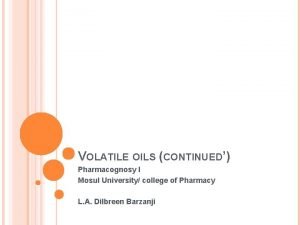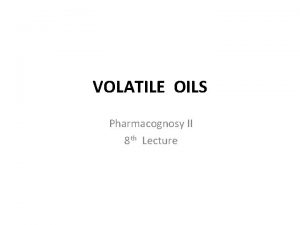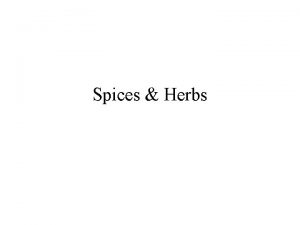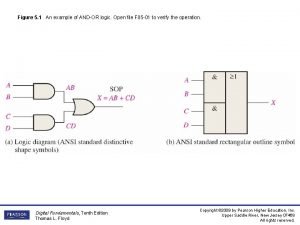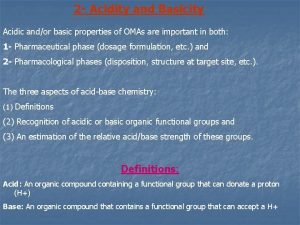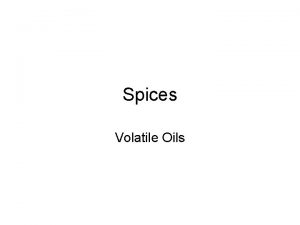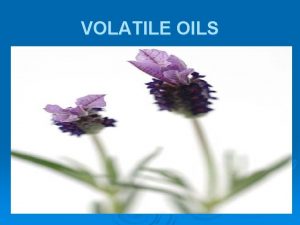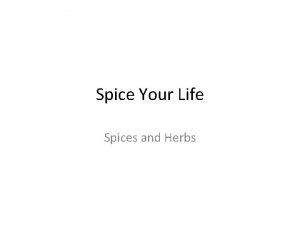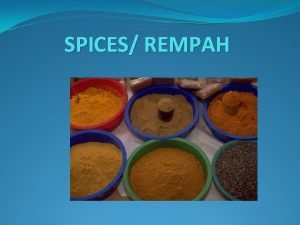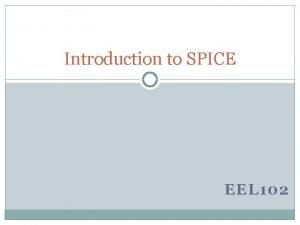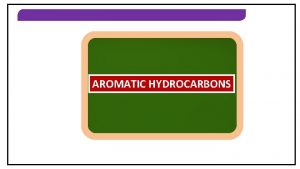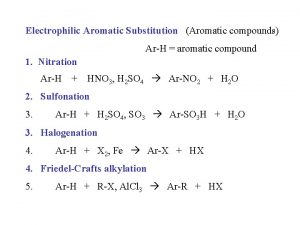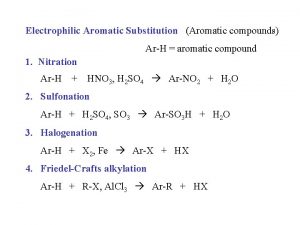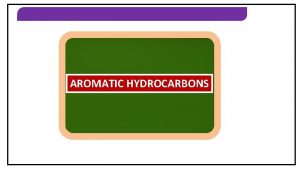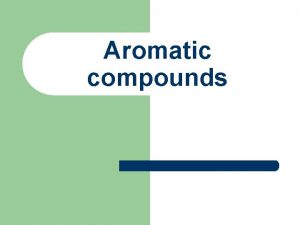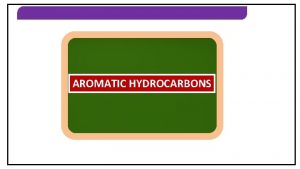Spices Volatile Oils Introduction Spice An aromatic andor













- Slides: 13

Spices Volatile Oils

Introduction • Spice: An aromatic and/or pungent plant product, employed for imparting an aroma to food. • Food adjuncts, and owing to their principles , stimulate secretion of gastric juices, thereby increasing appetite and aiding digestion. • Has very small nutritive value, though some possess appreciable amounts of proteins, starches and oils

History • Spices were much sought out products and used in preservatives, beverages, medicines, and even exchange for money • Spices were among the first objects of commerce between East and West • Columbus’s famous voyage was inspired by the idea of finding a shorter route to India, the home of many spices

Uses • Important food adjuncts – Help to avoid monotony – Disguise unpleasant odor – Aid digestion – Increase rate of perspiration, resulting in lowering body temperature. • Medicinal – carminative and antispectic • Perfumes, soaps, incenses, dyes

Chemistry • Terpenes, alkaloids, phenols and sulfur containing compounds • Volatile oils, or essential oils • Terpenes: Basic unit is isoprene unit (C 5) • Monoterpenes (C 10): small non-polar therefore volatile.

Ecology • Volatile compounds used to attract pollinators and repel herbivores. • Some compounds are allelopathic prevent the growth of other plants via inhibition of germination and killing competitors.

Herb or a spice? ? • What’s in the name?

Spices from Mediterranean Region Lamiaceae • • Mint family with fragrant leaves. Mainly has monoterpenes such as carvone, thymol, menthol. . Also contain gums, resins and tannins; carminative Rosemary - Rosmarinus officinalis – borneol; used mainly tea, perfume, and cooking Thyme - Thymus vulgaris – Thymol; mouth washes, cough drops, cooking Oregano - Origanum vulgare - Italian food Marjoram - Origanum majorana - milder flavor than oregano Basil - Ocimum basilicum - basil - pasta sauces Sage - Salvia officinalis - Used medicinally by Greeks through Middle Ages but modern testing indicates sage has no medicinal properties. Used to flavor poultry and other meats, especially sausage. Spearmint - Mentha spicata Peppermint - Mentha peperita - most frequently used mint - jelly, candy, medicines, obnoxious gum commercials, etc.

Magic Mint • Sage plant: Salvia divinorum – Active ingredient, Salvinorin A, is a powerful hallucinogen; Dr. Bryan Roth, Case Western Reserve University – Same as LSD – specific to a single receptor in the brain. – Most potent naturally occurring hallucinogenic drug – Similar to opioids – an instantaneous trip to another time and place – Usually unpleasant

Carrot family Apiaceae • Fruit is a cremocarp, with two easily separable mericarps (looks like seed) Different set of monoterpenes. Limonene, pinene, linool. • Herbage – Parsley - Petroselinum crispum – garnish – Chervil - Anthriscus cerefolium – Dill - Anethum graveolens – pickling – Cilantro - Coriandrum sativum - Mexican, Indian dishes • Dried fruits (Spices) - fruit is composed of pericarp and seed, oils are in fruit wall – Fennel - Foeniculum vulgare - Italian sausage – Cumin - Cuminum cyminum - Indian and Mexican foods – Anise - Pimpinella anisum - Licorice flavor – Celery seed - Apium sativum – Caraway seed - Carum carvi -rye breads, sauerkraut

Brassicaceae • Glucosinolates changing to thiocyntes upon crushing – Sulfur containing compounds – Myrosinase (enzyme) spatially separated; hydrolyses the compound • Spices: – Black mustard - Brassica nigra - native to Europe – White mustard - Brassica alba – Horseradish- Armoracia rusticana - grated roots • Odds and ends Tarragon - Artemisia dracunculus – Asteraceae; used in vinegar in S. Russia Bay leaves - Laurus nobilis – Lauraceae; from Meditteranean Saffron - Crocus sativus - Iridaceae (Iris family), most costly spice, comes from stigmas, requires 150, 000 flowers/kg

Spices from Old World Tropics • "True" cinnamon - Cinnamomum zeylandica "Common" cinnamon Cinnamomum cassia (Lauracceae) – Both cinnamons are from SE Asia and are obtained from the bark. Tannins, mucilage, starch and sweet mannitol. • Cloves - Syzygium aromaticum – Myrtaceae; from Spice Islands or Indonesia, harvested as immature flower buds, used in Indonesian cigars, clove oil, but oil can be synthetically produced. • Nutmet and mace - Myristica fragrans - nutmeg is the dried endosperm of seed, not a true nut, toxic in large quantities, put on egg nog; mace is netlike aril around seed. Myristicin – hallucinogenic. • Cardamon - Elettaria cardamomum – Zinger family; oils originally used in medicine, now used in Indian cooking and Danish pastry • Ginger - Zingiber officinale – rhizome • Pepper - Piper nigrum - drupes, most important spice in terms of quantities, can make raw drupes into black or white pepper depending on processing

New World Spices • Allspice - Pimenta dioica - mostly grown in Jamaica, combination of flavors of cinnamon, cloves and netmeg. Unripe fruit –eugenol • Peppers: – Bell peppers, chiltecpin (tiny and hot) - Capsicum annuum paprika is made from dried, powdered members of this species – Pungent peppers - Capsicum fructescens - tabasco sauce Compound responsible for hot flavor is capsaicin, which is contained in the placenta • Vanilla - Vanilla planifolia - only crop from Orchidaceae over 20, 000 species in this family, fruit is called a bean but is a false berry from an inferior ovary, vanilla is the 2 nd most expensive spice due to laborious cultivation and processing requirements, vanilla can be made synthetically but taste is inferior to natural vanilla.
